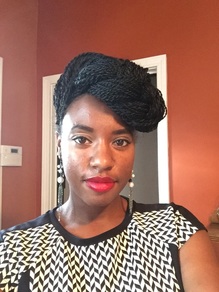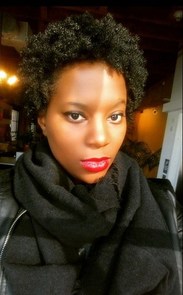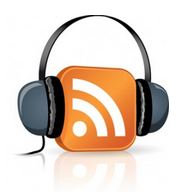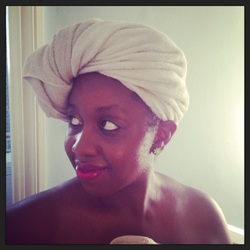
First things first, what on earth is a microfiber towel?
Microfiber (or microfiber here in Britain) is a synthetic fiber that is finer than one denier - this diameter is smaller than a strand of silk. A microfiber towel is less fluffy than a regular cotton towel but is actually much more ideal for drying hair because:

How do you use a microfiber towel?
After washing my hair I give it a gentle squeeze to get rid of the dripping and then I wrap the microfiber towel over my head and let it get to work. You don't need to rub or scrunch at all. A gentle pat over the surface is enough. Where can you get a microfiber towel? I got links to the top rated microfiber towels on Amazon.com and .co.uk below. I have Mimi's Diva dryer. It's what I have on my head in the photos.
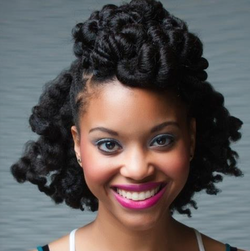
Washing your hair once a week is enough.
Type 4 (kinky and curly) hair doesn't get greasy as badly and as quickly as straight hair does for the very reason that it is kinky or curly. Why greasiness is not an issue Sebum, the natural oil produced by the scalp struggles to move up the kinks, curls and coils of type 4 hair. This means that dryness is much more of a problem for curly and kinky haired types than greasy hair and overwashing just exacerbates the problem. Tangling is a big issue The washing process is prime time for hair to get tangled and knotted.
But I go to the gym a lot? Personally my hair doesn't take on a stench when I exercise even when I sweat heavily so I just stick to my weekly wash. I frequently make one of my workout days coincide with my wash routine. Of course, your hair's moisture level, tendency to get knots and tangles and sweat pattern will be different to mine so you need to find the right wash-regularity for you.
Many of us were brought up to believe greasing one’s scalp with “hair food”, such as Blue Magic, Sulfur 8 or any other petrolatum-based grease was essential for maintaining healthy hair. However, many in the natural hair community now argue that greasing your scalp is not essential. So is it? It depends…
Day-to-Day Management Generally, a clean and healthy scalp does not need to be greased to stay soft, pliable and well suited for hair growth. Sebum, the oil naturally produced by the scalp lubricates the scalp on an on-going basis. Importantly, unlike skin, the scalp is not constantly chaffing against clothing or rubbing against furniture so it doesn’t need to be moisturized as intensely or as regularly as skin does. Dry Scalps The above said, just as some people have drier skin than others, some scalps are more dry than others. The dryness of one’s scalp can be impacted by diet and weather. Whatever the case, if your scalp doesn’t seem to lubricate itself and perhaps gets all dry, ashy or dandruff-ridden then it certainly doesn’t hurt to oil it. If your scalp is dry, don’t use a thick or heavy grease; choose a light, nutrient-rich oil to rub into your scalp.
When In Plaits If your hair has just been plaited/braided then it might be useful to oil your scalp to prevent bumps and rashes from forming where the root has been pulled. I personally have a very sensitive scalp; even with minimal pulling my scalp gets sore and bumpy so I oil the scalp religiously for about a week after its been plaited using Neno Natural’s Hair Growth Stimulator when I have just had braids installed. After a week the new growth compensates for the pulling my scalp endured. Hair Growth Last but not least, because the scalp is so thin, you can promote the delivery of oxygen and nutrients to the scalp to help hair grow by massaging it with an oil + essential oil blend. I have quite a few recipes that you can blend yourself. https://www.youtube.com/playlist?list=PLu2772_DbH-LWFfnvzHn-uN6bw4LgX4_b What do you think about greasing the scalp? Is it essential for you? 
Get your FREE ebook on How To Grow Long, Healthy Natural Kinky or Curly Hair. You might also like: Working with Essential Oils - Understanding Dilution 
I get a lot of emails from mums and grandmothers with concerns about hair growth so I decided to go straight to the root of the issue – pun not intended.
You are what you eat. A healthy body including fabulous hair and skin is all down to the content of your diet. An affinity for healthy foods is best taught at a very early age. Now that our son - Little Zeusy - is 4.5 months old we’re thinking hard about when and how to introduce solids. Given women have been having babies for centuries you’d be forgiven for thinking that issues regarding the introduction of solids would be pretty decided by now but scientists are very much “still working on it”. I’m getting a lot of conflicting advice. Rather than focus exclusively on the science, I’ve decided to balance the science with my own intuition and stories from other mums’ experiences. What are the outcomes I want for Little Zeusy, ideally?
What I Learnt at the NCT Workshop on Introducing Solids? When to introduce solids? Experts recommend you wait until your baby is 6 months old or approaching 6-months or is showing the following 3 signals:
Baby-led vs. Parent-led (Pieces of food vs. Pureed food) Baby-led weaning basically involves giving your baby real food. You don’t mush it up for the most part, you simply cook it or, if it’s soft e.g. avocado or banana, cut it up into pieces and let the baby feed himself. The session I attended had an experienced mum overseeing how it was conducted and I was convinced by her story: she gave birth to a set of twins when her first two children were 4 and 2 years old. She weaned her first two children by pureeing things initially but when she had the twins she just fed them whatever her other kids were eating. She says the results were amazing: her twins accepted a much wider variety of food over time and to-date her first child who is 12 years old still struggles with vegetables. The most amazing thing she found is that her twins (now 8 years old) just stop eating when they are full because that’s what they’ve grown up to do. Even if they are eating a food they like such as cake once they’re full they’ll simply stop eating. I would never have believed this to be true if I didn’t live with that kind of person: my husband, Harry, can leave 3 crisps in a packet, roll it up, clip it and put it back in the cupboard. I was flabbergasted the first time I found a bag of crisps with literally 3 crisps in it. When I asked why he bothered to leave them he simply said, “I was full.” Ultimately, letting a child feed himself is like breastfeeding: the child stops when they have had enough. When a parent feeds their child they want to clear the plate or empty the bottle whether the baby is full or not, that’s natural. What time of the day to introduce foods? She suggested introducing new foods Monday to Friday in the morning when GP surgeries are open and A&E is better staffed in case there is an allergic reaction. I think this is overly cautious but in principle I would agree. We’ll probably do it in the evening so my husband can take part. Given he’s a paediatrician it should be okay. Commercially packed food or homemade food? Nowadays you have so much pre-packed food in sachets, cans, etc. “Ella’s” is all the rage. The main problem I have with these foods is that they’re NOT food as you would have at a regular meal. Apparently some babies that become accustomed to foods from sachets where they squeeze the pack to get the food out can reject food that doesn’t come in something that they squeeze out. To solve this problem nowadays you can buy empty “squeezey” satchets to fill up with mashed up food yourself… A second problem is that when you are weaning a baby they need very little food; however, these sachets/jars expire within about 48 hours of opening them, this means unless you’re making the baby finish the food (which you shouldn’t do, always stop when the baby indicates he’s full) you’ll be throwing loads away. I see the value of pre-packed food if you’re travelling somewhere but not as a lifestyle choice. Personally, I’m planning not to buy any at all. It’s a very unnecessary expense and isn’t in agreement with the mostly baby-led weaning my husband and I want to try and follow. Raw or cooked? Apparently, most food should be baked, steamed or boiled initially to reduce choking risk. I was going to let the baby suck on raw carrots but apparently this isn’t advised due to the choking risk. I’ll do more research on this. Sweet vs. Savoury? Because breast milk is sweet, babies are more likely to accept sweeter foods, e.g. parsnips than savoury foods. However, someone I know says she’s worked with some babies that rejected savoury foods because the weaning process focused too much on sweet foods. One set of twins she cares for only accept savoury foods if they are dipped in a sweet food first. Ultimately, the weaning process needs to be slow and gradual. Breast milk or formula is meant to be the primary source of food for the first year of life and up until the 6-month point provides everything the baby needs from a nutrient perspective. There is a lot of new information coming my way right now but I’d like to know your experience. What worked and what did not work when it came to introducing food to your baby? 
Get your FREE ebook on How To Grow Long, Healthy Natural Kinky or Curly Hair. You might also like: Working with Essential Oils - Understanding Dilution |
I now blog about wealth creation - so if you have any money questions meet me there, you can do all sorts of cool things like leave me a voicemail.
By Heather Katsonga-Woodward
I was a natural hair blogger and mixtress living between London & Chicago from 2012 to 2017. I always thought I was 4C but some say 4B; images below - you decide! Heather xx Categories
All
Archives
November 2016
|

